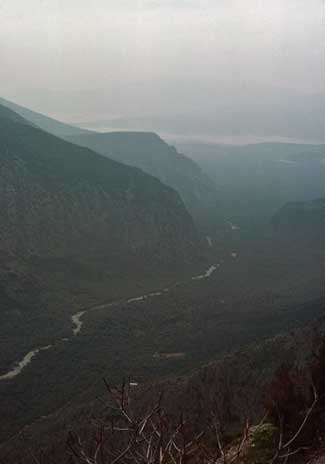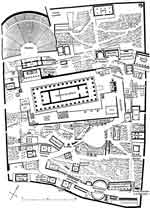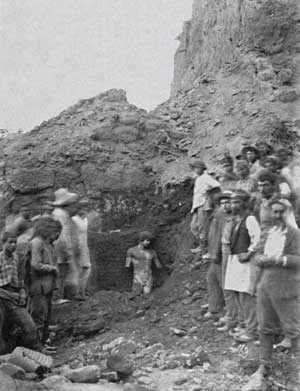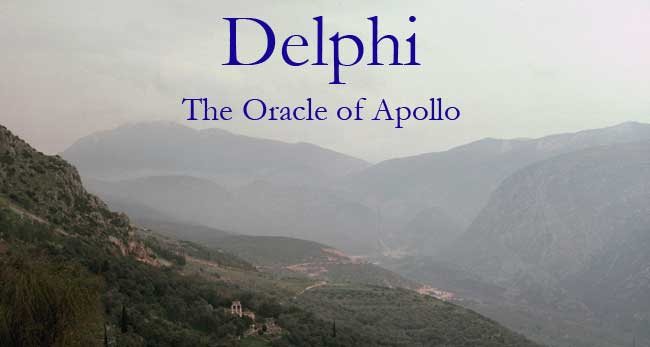
The Sanctuary
The earliest reference to the site occurs is made by Homer who may have lived as early as 800 BC (but whose poems may not have been committed to writing until as much as 250 years later). He refers to the wealth of “rocky Pytho” and says that Agamemnon consulted the oracle before setting out for Troy. Delphi’s reputation soared during the period from about 800-500 BC. This was the great age of Greek colonization when new cities were founded all over the Mediterranean and Black Sea coasts, and it would have been pure foolishness for a city to undertake such an important venture without consulting the gods, especially 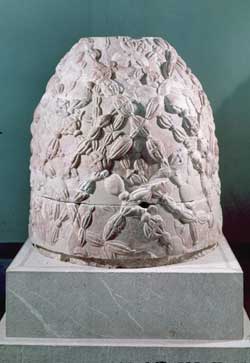 Apollo, about a suitable location. If it was a success and the new foundation grew in wealth and power it would express its gratitude by endowing the sanctuary with gifts.
Apollo, about a suitable location. If it was a success and the new foundation grew in wealth and power it would express its gratitude by endowing the sanctuary with gifts.
Delphi came to be considered the centre of the world—not just metaphorically but literally. The story goes that Zeus released two eagles, one at the eastern edge and one at the western edge of the world. They met at Delphi and the spot was marked with the omphalos (“navel”), the stone that his mother Rhea used to deceive Kronos, who had a nasty habit of swallowing his offspring. The actual stone, which was probably a meteorite, sat in the heart of the Temple of Apollo and was flanked by a pair of golden eagles. The one shown (right) is a Hellenistic or Roman replica and was found in front of the temple. It is covered by the agrenon, a carved network representing the knotted woollen strands wrapped around the original, the swaddling robes of the infant god. The replica is hollow and perhaps the original was too (a conduit for the vapours rising from below?).
As the fame of the oracle grew, individuals and delegations came from all over the Greek world and beyond—the pharaoh of Egypt and the kings of Lydia in what is now western Turkey consulted it. The priests at Delphi must have been among the best-informed people around. According to Herodotus, when Croesus of Lydia was trying to determine the location of the most reliable oracle in the world, he sent embassies bearing gifts and a test question to all the famous contemporary oracles, including that at Didyma in Ionia and Siwa in the Libyan desert. On the hundredth day after their departure and at the appointed time, they were supposed to ask each of them what the king was doing just then. Only the Pythia gave the correct answer, that he was making a stew of lamb and tortoise in a bronze bowl—a pretty fortunate reply if it was mere guesswork.
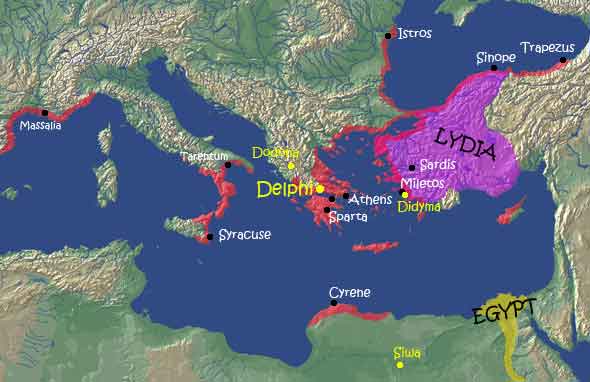
Map of the Greek World in the Age of Colonization (noted oracles are in yellow)
By the 6th century BC, business had become so brisk at the sanctuary that many of the Greek city-states (poleis) built treasuries to store all of the many small but valuable objects given to the god in gratitude 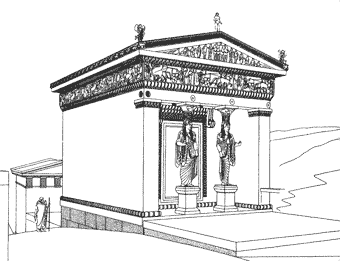 by their citizens. Naturally, since these buildings were seen by people from all over the world, they became a means to advertise the wealth and power of the individual polis through competitive decoration.
by their citizens. Naturally, since these buildings were seen by people from all over the world, they became a means to advertise the wealth and power of the individual polis through competitive decoration.
The illustration (left), from Georges Daux and Eric Hansen’s Le Tresor de Siphnos, shows the treasury set up by the people living on the island of Syphnos in the Cyclades. So much wealth was concentrated at Delphi that it became, in essence, the central bank of the Greek world. Of course, this made a tempting target for cash-strapped Greek politicians as well as for outsiders. It was undoubtedly the cause of the First Sacred War (595-586 BC) which ended with the creation of the Amphictyonic League, a federation of 12 city-states, including arch rivals Athens and Sparta, which reorganized and presided over the Pythian Games. In 548 BC when fire destroyed the 8th century temple of Apollo, funds were raised from all over the Mediterranean to rebuild the temple and enlarge the sanctuary.
During the period of the Persian Wars, the oracle took a decidedly pro-Persian stance and advised the Greeks to submit to the inevitable but, when pressed, it advised Athens to trust in their wooden walls. The people of Athens were saved by evacuating to Salamis and relying on their fleet for deliverance. The site of Delphi itself was saved from the Persians by a 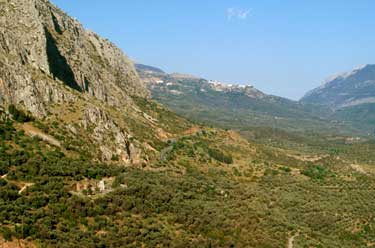 miraculous landslide. Through the latter part of the fifth and the early fourth centuries BC, there were three more Sacred Wars (448, 356, 340 BC) between various Greek city-states over control of the sanctuary and its sacred lands in the Krisaean plain below.
miraculous landslide. Through the latter part of the fifth and the early fourth centuries BC, there were three more Sacred Wars (448, 356, 340 BC) between various Greek city-states over control of the sanctuary and its sacred lands in the Krisaean plain below.
In the fourth century BC, Delphi came under the influence of Macedonia and benefited from a period of enlargement and refurbishing. In 279 BC the sanctuary was again saved by a timely earthquake, this time from an invasion of barbarian Gauls. The Pergamon dynasts, famous for their battles with the Gauls, were generous patrons of the sanctuary in the third century BC and built a stoa (the Stoa of Attalos I) as well as refurbishing existing monuments. Control of the sanctuary then passed to the Aetolian League (290-190 BC) before falling to the Romans in 189 BC. Sulla plundered the site in 86 BC, and later Nero is recorded to have carted off 500 bronze statues  back to Rome in 51 AD. Even so, there was still a lot to be seen when Pausanias visited the site during the reign of the emperor Hadrian (117-138 AD).
back to Rome in 51 AD. Even so, there was still a lot to be seen when Pausanias visited the site during the reign of the emperor Hadrian (117-138 AD).
There was a steep decline in the fortunes of the sanctuary during the latter years of the Roman empire, particular after Constantine’s conversion to Christianity. The old gods seemed unable to cope with the series of disasters that seemed to characterize the times. When the emperor Theodosius banned all of the pagan cults in 385 AD, the sanctuary was utterly demolished by the local Christians, its statues smashed and the very foundations of the temple buried beneath the rubble. By the nineteenth century it lay forgotten beneath the village of Kastri (left). Some of the other buildings, outside the main sanctuary, survived in better condition. The treasuries on the Athena Pronoia terrace were later used as houses and a monastery was established within the walls of the gymnasium.
Layout
The layout of the sanctuary was established in all its essentials during the Archaic Period, which ended in 480 BC. It is a trapezoid enclosure measuring roughly 145 x 195 metres at its maximum and running SE-NW up the rather steep slope. The central element is, of course, the Temple of Apollo itself, which sits on a platform about halfway up. The principal entrance is in the eastern

corner of the enclosure and from there the Sacred Way zigzags its way past the various memorials and civic treasuries up to the temple. Above the temple and at the rear of the enclosure is the theatre and beyond it, outside the enclosure, lies the Stadium. A number of buildings were appended to it and the temple was rebuilt on more than one occasion but essentially it stayed the same until the sanctuary was shut down by Theodosius.
Modern Research
The French Excavations
Towards the end of the nineteenth century, when the foreign schools of archaeology were being formed and given a choice of sites, the French School of Classical Studies of Athens chose Delphi as 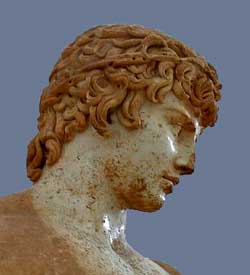 one of their allotted three. Despite some fairly stiff competition from the Americans, the French were granted exclusive rights in 1891. As part of the agreement (and a necessary precondition to excavation) was the removal and relocation of the existing village, which was accomplished in 1892. Excavations have continued (off and on) between then and now and are published in the monumental series Fouilles de Delphes.
one of their allotted three. Despite some fairly stiff competition from the Americans, the French were granted exclusive rights in 1891. As part of the agreement (and a necessary precondition to excavation) was the removal and relocation of the existing village, which was accomplished in 1892. Excavations have continued (off and on) between then and now and are published in the monumental series Fouilles de Delphes.
They began by tracing the Sacred Way, uncovering the foundations of the ancient treasuries along with some statues, most notably that of Antinous, the lover of the emperor Hadrian (left). The remains of the Temple of Apollo were a bit of a disappointment, to say the least. The building had been thoroughly destroyed by the Christian vandals and the effects of earthquakes and landslides over the centuries had disturbed the shattered remains of the foundations. The damage was particularly acute in the area of the adyton, the holy of holies. To their surprise, the French apparently found no trace of a fissure, let alone a chasm, and no hint of intoxicating gases.
An English scholar with the very French name of Adolphe Paul Oppé published an influential article dismissing the ancient accounts as frauds that had been foisted on gullible scholars, whatever their credentials, by the locals. In 1950, Pierre Amandry, who had worked at Delphi and later directed the French excavations there, added his support claiming that no gaseous emissions were even possible in a volcanic zone such as Delphi. However, neither of these men were geologists nor had any geologists been involved in the debate to that point.

